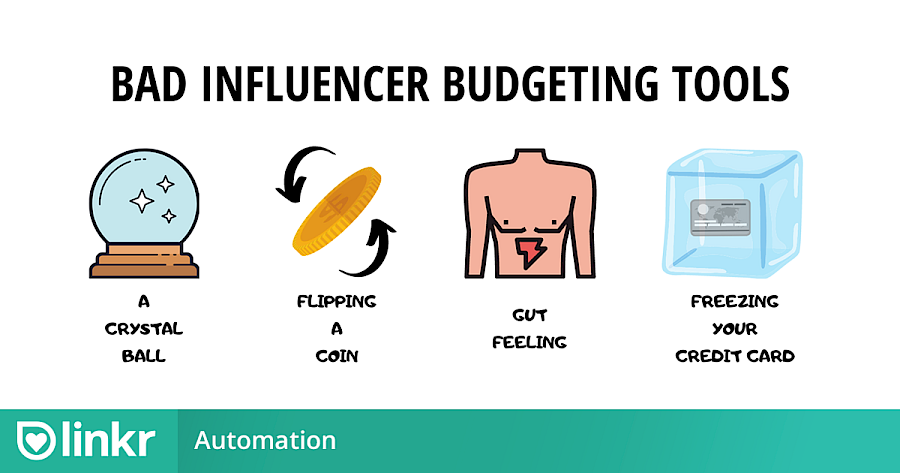One of the things that marketers struggle with when it comes to working with influencers is setting the right budget. Influencer marketing cost includes not just the compensation you give to influencers. It involves overhead that many companies fail to take into account at the start. Nonetheless, a well-outlined budget is a recipe for successful campaigns that don’t leave you feeling overcharged and shortchanged.
Over the years of working with brands, we have recognized the common problems that come with preparing an influencer marketing budget. These problems can be avoided by following these tips:
Understand what influencer marketing is - and what it is not
Among all types of digital marketing, influencer marketing is the most recent. Because it’s relatively young, most companies and even some marketers fail to understand what it is. They sometimes approach it the way they approach celebrity advertising, wherein they look for high profile personalities to have them feature their brand. This is one of the tactics that gave influencer a bad rep and is a surefire way to blow your budget.
It’s not just celebrities but also the big influencers with no real niche and so can’t deliver campaigns deemed authentic by audiences. This is why companies are gravitating to smaller content creators. These niche-focused specialists on social media draw real engagement at a cost that’s quite reasonable for most brands.
Outline clearly defined goals

We keep coming back to goals because your goals determine not only your strategy and results but also your budget. If you don’t know exactly what your goals are, simply ask yourself why you want to work with influencers. What do you want to achieve by working with them? What are the results you are looking for? This can be things such as sourcing of branded content that you can re-use on your social media channels. Brand exposure and awareness among your target audience in the form of views on branded posts. Visitors on your website or online shop, etc.
Once you know your goals, it’s time to set up a budget breakdown:
Don’t just go for vanity metrics
If your budget allows you to work with an Instagram influencer with nearly 1 million followers, keep in mind that the same budget most likely allows you to work with several small influencers and possibly gain a similar, if not wider, reach. Just looking at the follower count when identifying content creators is a sure way to create a bloated influencer marketing budget. The engagement and conversion that an influencer can generate are more important metrics than plain follower count.
Make a reasonable budget
Your budget will, to a certain degree, of course determine what happens to your influencer campaign. This doesn’t necessarily mean that you need to spend more to achieve your goals more effectifely. It’s just that having more resources allows you to do more, but you can always maximize whatever you have and explore creative ways to foster brand awareness or convert audiences to customers without breaking the bank.
In addition, you should be realistic when anticipating the outcomes of your cooperations. A single collaboration will almost certainly not result in a short-term spike in sales. Like with any other form of marketing, retargeting is also important when it comes to influencer marketing - or when was the last time you immediately bought a product or service, right after you‘d seen it in an ad for the very first time?
Are we saying that multiple cooperations are better than one-off campaigns?
Yes.
You can work with the same content creators once you establish a relationship with them. One way to make that possible is to compensate them reasonably. And no, your product samples aren’t the compensation.
How much you pay your influencers should be reflected in your budget:
Calculate a fair influencer compensation

There are different influencer pricing models, but the trend moves toward upfront payment arrangements, wherein the brand and the influencer agree on a compensation for each post, upload, or video.
This pay-per-post model protects both the company in case the campaign goes viral and becomes unexpectedly effective and the influencer in case the campaign fizzles into oblivion.
In this model, influencer marketing cost is subject to 2 main driving forces:
- Content
- Performance
Content: The cost for creating content varies depending on the types of posts being made. In a nutshell, the more work it takes to create a post, the higher its value. Writing a blog post entails more work and consequently is more expensive than editing and captioning an Instagram photo. A YouTube video is more expensive than a blog post for the same reason.
Performance: This basically translates into calculating the post’s media value. Without taking into account the objective value of a post based on measurable factors, you’re at risk of either overpaying or under-compensating the content creators.
The media value of a post depends on the influencer’s reach, the engagement on the post, and the generated traffic. It also varies from social media platform to another - CPM on Instagram, for example, is much lower than its equivalent on YouTube.
The more reach and engagement, the higher the media value of a post. With the exception of post going completely viral, reach and engagement metrics per posts are quite predictable. Professional influencers on Instagram are posting several times a day, so there‘s a trendline you can look at. If the last 100 posts had x reach and y engagement, the 101st post is not going to look drastically different.
https://www.instagram.com/p/CC_b6oCC4D8/
So calculating these figures means you need to look at quite a bit of data and also assumes you’ve got that data at your disposal, which is why calculating a feasible compensation for multiple cooperation is often problematic, even for companies with dedicated staff. This task, nevertheless, can be automated using an influencer marketing software that computes the right price for each cooperation.
Other pricing models like pay-per-click and pay-per-acquisition, wherein content creators get paid based only on results, aren’t popular options - at least not among influencers, because these models not only disregard the amount of work that goes into creating content but also leaves compensation for influencers subject to factor the can‘t fully control. For example, if an influencers sends people to your shop and they‘re not buying because you have not yet found the right price-point, don‘t have a mobile friendly checkout, do not support a certain payment method,... the influencer has actually done her / his duty but still doesn‘t get paid.
Make detailed and compelling proposals
Once you determine the media value of the influencer, you can make a proposal that’s reasonable both for you and your potential partner. This becomes challenging when you have to draft proposals for 20 micro-influencers of different sizes. This won’t be a problem with a software solution that allows you to send multiple proposals, each of which is based on the value of each content creator.
Final Thoughts

You can spend hours every day estimating the cost of every influencer campaign, but that’s a terrible way to spend your time. Setting the right influencer pricing is important, but there are more important tasks on your plate that you have to attend to, such as product development, business planning,...
The good news is that you can choose a software solution that provides automatic budgeting and allows you to automate proposals so that you won’t have to call the content creators one by one.
Setting a budget for a campaign can be tough. You don’t have to do needless computations, though, when you sign up for linkr’s influencer marketing plans. You don’t have to worry about pricing your campaigns and negotiating with multiple influencers at once. Sign up for the GROWTH subscription for 49 EUR per month now!



